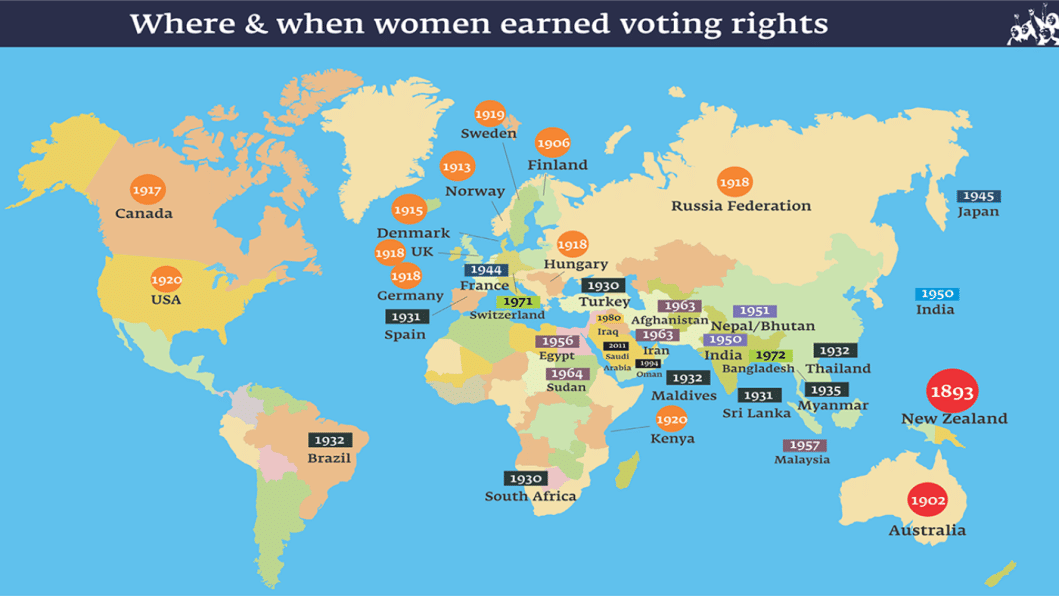The long struggle of women to achieve voting rights

New Zealand was the first country to give women the legal right to vote in political elections in 1893. Saudi Arabia has become the last one to grant women the right to vote in 2011.
UK, known as birth place of Westminster model of parliamentary democracy, was lagging behind New Zealand, the then self-governing colony of British Empire, to grant women the right to vote.
The South Australia, another colony of British Empire, did the same in 1894 and women were able to vote in the election in 1895.
Before 1918 no women were allowed to vote in parliamentary elections in UK. They had to fight for a long time for the rights. The law which was made in 1918 to provide women with the voting rights was discriminatory. It allowed women over the age of 30 who met a property qualification to vote.
The same law favoured men as it abolished property and other restrictions for men and extended the right to vote to all men over the age of 21. Even men in the armed forces could vote from the age of 19.
Women had to struggle for another decade to get equal rights until 1928 when Equal Franchise Act was made. Women over 21 were able to vote and women finally achieved the same voting rights as men.
Women of United States of America had to fight for around one hundred years to get the right to vote. Some states of the USA though provided women the right to vote, but they were not given the right to exercise the franchise until 1920. After the ratification of the 19th Amendment to the Constitution, all American women were guaranteed the right to vote in 1920 election.
The First World War changed the popular mood in global politics about women. Most independent countries enacted women's suffrage in the interwar era.
Leslie P Hume, an American historian and philanthropist, in her authoritative book "The National Union of Women's Suffrage Societies" wrote that the women's contribution to the war effort challenged the notion of women's physical and mental inferiority and made it more difficult to maintain that women were, both by constitution and temperament, unfit to vote.
"If women could work in munitions factories, it seemed both ungrateful and illogical to deny them a place in the polling booth. But the vote was much more than simply a reward for war work; the point was that women's participation in the war helped to dispel the fears that surrounded women's entry into the public arena," she wrote.
Among the Muslim countries, Turkey was the first country to grant women the right to vote in 1930. Mustafa Kemal Atatürk who transformed Turkey a secular republic by abolishing the Ottoman Sultanate gave the women voting rights.
Some other Muslim countries however were slow to give women voting rights. Qatar, Kuwait and United Arab Emirates offered women the rights in 2003, 2005 and 2006 respectively.
When women in UK were about to get the rights, women in the Indian sub-continent which was a colony of British Empire started demanding the right to vote. The Women's Indian Association which was founded in 1917 demanded voting rights for women. The then main political parties-Indian National Congress and All-India Muslim League supported the demand.
In 1919, the British set up provincial legislatures which had the power to grant women's suffrage. Madras in 1921 granted votes to wealthy and educated women, under the same terms that applied to men. Some other provinces followed.
In Bengal province, the provincial assembly rejected it in 1921. The women leaders in Bengal linked their crusade to a moderate nationalist agenda, by showing how they could participate more fully in nation-building by having voting power.
In the Government of India Act 1935 the British Raj set up a system of separate electorates and separate seats for women. Most women's leaders opposed segregated electorates and demanded adult franchise. In 1931 the Congress promised universal adult franchise when it came to power. It enacted equal voting rights for both men and women in 1947.
Consisted of two wings--East and West-- Pakistan was part of British Raj until 1947, when it became independent. Women received full suffrage in 1947. Muslim women leaders from all classes actively supported the Pakistan movement in the mid-1940s. Their movement was led by wives and other relatives of leading politicians. Women were sometimes organized into large-scale public demonstrations.
Being a part of Pakistan, women in Bangladesh have had equal suffrage since 1947. Bangladesh became independent in 1971 and its new constitution adopted in 1972 also guarantees women equal voting right as men.

 For all latest news, follow The Daily Star's Google News channel.
For all latest news, follow The Daily Star's Google News channel. 



Comments